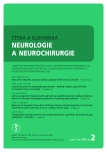Reversal of Traumatic Pentaplegy after Combined C1–C2 Fracture
Authors:
R. Lukáš 1; P. Barsa 2
Authors‘ workplace:
Krajská nemocnice Liberec, a. s.
Traumatologicko-ortopedické centrum
1; Krajská nemocnice Liberec, a. s.
Neurocentrum
2
Published in:
Cesk Slov Neurol N 2012; 75/108(2): 240-243
Category:
Case Report
Overview
Otherwise healthy 32-year-old man was found quadriplegic and without any signs of breathing at a site of his fall from a body of a truck. The diagnosis of three fragment Jefferson’s type fracture of atlas together with incidental type II fracture of the dens of C2 was made at an emergency unit were the mechanically ventilated patient was transported. MRI subsequently revealed C0–C3 spinal cord oedema. Surgical stabilization of the fracture of both uppermost cervical vertebras was postponed to the third day after the trauma due to the patient’s haemodynamic instability. The circulatory system instability was also the reason for selecting the anterior approach. A combination of anterolateral transarticular screws together with a single screw for direct osteosynthesis of the dens stabilized the C1–C2 complex. At day 10 of post-surgical passive physiotherapy, the patient began to interfere with the mechanical ventilation. Gradual reversal of neurological deficit continued, so that three weeks after the trauma, the patient developed a sufficient spontaneous breathing. Improving paraparesis allowed him to walk. The patient, walking just with a pathological gait stereotype, continued his functional treatment at a specialized rehabilitation institute eight weeks after the accident. This extremely positive outcome supports the use of a proactive and early surgical approach even in patients with complete spinal cord injury at the upper cervical levels.
Key words:
upper cervical spine injury – post-traumatic oedema of the spinal cord – stabilisation
Sources
1. Lesoin F, Autricque A, Franz K, Villette L, Jomin M. Transcervical approach and screw fixation for upper cervical spine pathology. Surg Neurol 1987; 27(5): 459–465.
2. Aarabi B, Koltz M, Ibrahimini D. Hyperextension cervical spine injuries and traumatic central cord syndrome. Neurosurg Focus 2008; 25(5): E9.
3. Šrámek J, Štulík J, Šebesta P, Vyskočil T, Kryl J, Nesnídal P et al. Hyperextenční poranění krční páteře při spondylóze. Acta Chir Orthop Traumatol Cech 2009; 76(2): 128–132.
4. Flanders AE, Spettell CM, Tartaglino LM, Friedman DP, Herbison GJ. Forecasting motor recovery after cervical spinal cord injury: value of MR imaging. Radiology 1996; 201(3): 649–655.
5. Selden NR, Quint DJ, Patel N, d‘Arcy HS, Papadopoulos SM. Emergency magnetic resonance imaging of cervical spinal cord injuries: clinical correlation and prognosis. Neurosurgery 1999; 44(4): 785–792.
6. Dvorak MF, Fisher CG, Hoekema J, Boyd M, Noonan V, Wing PC et al. Factors predicting motor recovery and functional outcome after traumatic central cord syndrome: a long-term follow-up. Spine 2006; 30(20): 2303–2311.
7. Tsutsumi S, Ueta T, Shiba K, Yamanoto S, Takagishi K. Effects of the Second National Acute Spinal Cord Injury Study of high-dose methylprednisolone therapy on acute cervical spinal cord injury – results in spinal injuries centre. Spine 2006; 31(26): 2992–2996.
8. Guigui P, Benoist M, Deburge A. Static and dynamic changes of the cervical spine after laminectomy for cervical spondylotic myelopathy. Rev Chir Orthop Reparatrice Appar Mot 1998; 84(1): 17–25.
9. Koller H, Kammermeier V, Ulbricht D, Assuncao A, Karolus S, van den Berg B et al. Anterior retropharyngeal fixation C1–2 for stabilization of atlantoaxial instabilities: study of feasibility, technical description and preliminary results. Eur Spine J 2006; 15(9): 1326–1338.
10. Apostolides PJ, Theodore N, Karahalios DG, Sonntag VKH. Triple anterior screw fixation of an acute combined atlas-axis fracture: Case report. J Neurosurg 1997; 87(1): 96–99.
11. Sen MK, Steffen T, Beckman L, Tsantrizos A, Reindl R, Aebi M. Atlantoaxial fusion using anterior transarticular screw fixation of C1–C2: technical innovation and biomechanical study Eur Spine J 2005; 14(5): 512–518.
Labels
Paediatric neurology Neurosurgery NeurologyArticle was published in
Czech and Slovak Neurology and Neurosurgery

2012 Issue 2
Most read in this issue
- The Use of Percutaneous Endoscopic Gastrostomy – Overview of Indications, Description of the Technique and Current Trends in Neurology
- Postural Instability, Gait Disorders and Falls in Parkinson’s Disease
- The Algorithm of CSF Examination according to the Reccomendation of the Committee of CSF and Neuroimmunology of the Czech Neurological Society
- Obstructive Sleep Apnoe and CPAP – is it Reasonable to Solve Nasal Patency?
